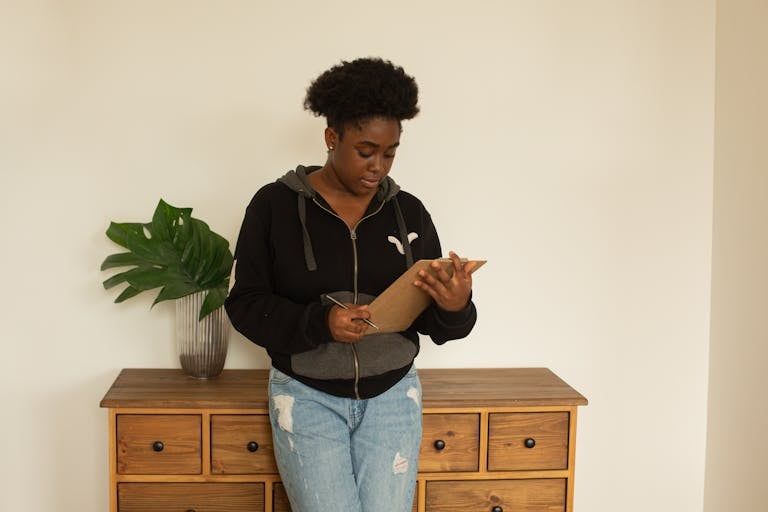ADHD Task Paralysis: 7 Brutal Truths + 5 Strategies That Actually Work
TLDR: ADD is an outdated term now replaced by ADHD. The old diagnosis only covered attention problems, missing symptoms like restlessness and impulsivity. The updated definition recognizes that hyperactivity isn’t just physical—it can be mental restlessness, especially in women.
ADHD task paralysis is a specific kind of stuck that happens when you know what you need to do, can picture doing it, but somehow you just… can’t. Your body refuses to move, and you find yourself stuck in the same spot as hours slip away.
This experience is fundamentally different from laziness, even though they can look similar. On the outside, you may look calm, but internally, there’s a voice screaming at you to just get up.
In my experience, it feels like the world is burning down around you as you watch without the ability to engage. A paper is due at 11:59, and it’s already 9 PM, bills need to be paid while the money sits in my account, and there’s a video game I’ve been wanting to play for weeks, but I struggle to start any of it.
The anxiety around not doing the task grows by the minute and makes it even harder to act. Shame piles on, and the cycle continues until either the deadline forces me to move or passes me by entirely.
Before we get into what helps, let’s talk about what’s really going on when you’re stuck.
What is ADHD paralysis?
ADHD paralysis is a breakdown in executive function, specifically in task initiation or the brain’s ability to start or switch between tasks.
There are typically three types:
- Mental paralysis (can’t think or process),
- Task paralysis (can’t start tasks)
- Choice paralysis (can’t make decisions).
In ADHD brains, there’s often lower dopamine activity, which is essential for motivation and movement.
When we discuss dopamine and motivation in the brain, the common misconception centers on fun activities or willpower. In reality, we’re talking about the brain’s ability to signal that basic, mundane tasks need to happen, like brushing your teeth, paying bills, or getting out of bed.
A clear example of this centers on hygiene: someone without ADHD will instinctively wake up and brush their teeth, not because it’s fun or rewarding, but because their brain naturally signals that it needs to be done.
For ADHDers, we experience executive dysfunction, which impairs that automatic signaling, so there’s little to no natural drive to do these maintenance tasks, even when we intellectually know they’re necessary.
When you’re trying to start a task (especially one that’s boring, overwhelming, or anxiety-inducing), your brain can’t generate enough of that dopamine signal to bridge the gap between intention and action.

ADHD Task Paralysis Symptoms
Paralysis appears in different ways depending on the day, the task, and how depleted you already are. Here’s what it can look like:
- You’re physically frozen, but your mind won’t stop racing through everything you need to get done.
- Too many tasks feel equally urgent, so you can’t choose where to start and end up doing nothing at all.
- Hours pass while you’re “busy,” but when you look up, nothing’s actually gotten done.
- Simple tasks like sending an email or making a phone call suddenly feel impossible.
- You struggle to switch between tasks, even when you want to move on to something else.
- You’re not just stuck physically, you’re also emotionally shut down or completely overwhelmed.
- Small logistical details (due dates, formatting, where to submit) derail you completely.
- You need to talk through or write out a task before actually doing it.
- You avoid tasks you’re good at or enjoy because the initiation feels impossible.
ADHD Paralysis vs Executive Dysfunction
ADHD paralysis is what happens when executive dysfunction gets so intense that you completely freeze.
Executive dysfunction covers all the ways ADHD impacts how you manage daily life: planning falls apart, you lose track of time, you forget what you were doing mid-task, organizing feels impossible, emotions hit harder than they should, and switching between activities takes way more effort than it seems like it should.

The ADHD brain has differences in dopamine regulation and executive function areas, which directly impact task initiation, motivation, and follow-through. Your brain’s executive function system includes the ability to start things (task initiation), decide what’s most important (prioritization), push through boring or difficult work (sustained attention), remember what you’re supposed to be doing (working memory), and switch gears when needed (cognitive flexibility).
When these systems get overwhelmed (too much stimulus, too many competing priorities) or understimulated (task is boring, no immediate reward), paralysis happens, and you’re left with the intention and knowledge but can’t coordinate your brain and body into completing the task.
How to Get Out of ADHD Paralysis
Breaking paralysis has nothing to do with willpower or discipline, which is probably why the same advice people without ADHD find helpful just makes you feel worse about yourself. You need strategies that work with how your brain actually functions, even if they look weird to people who don’t have this disorder.
Pair tedious tasks with stimulation
Sitting in silence and trying to push through never works for me. I need something else going on at the same time, like music that matches the energy I’m trying to access, or a show I’ve already seen playing in the background, so I don’t get distracted trying to follow a plot.
If it’s nighttime and I’ve scheduled myself for crisis counseling, I’ll make some warm milk with vanilla to calm my nerves as I get started. When I need to face laundry (my mortal enemy), breaking it down over a few days with a new show to binge makes the work more manageable. Sometimes I throw on my wearable blanket and over-ear headphones to wash dishes, and I can finish everything in the time span of a single video essay.
Extra sensory input gives my mind something to look forward to instead of wandering off or completely shutting down, and depending on the task at hand, these tiny adjustments are the difference between being able to start and staying frozen for hours.
Specific environments for specific tasks
I’ve started being more intentional about where I do what, so my bed is only for sleep and scrolling, my desk is for creative work, and the couch is for admin tasks like paying bills or responding to emails. Along with the set location, I have specific playlists or podcasts I only listen to during that time.
It sounds rigid, but it removes a layer of decision-making because my brain already knows “this is where I do this kind of work,” and task initiation gets a little easier.
Adding novelty helps too, which is why I’ll work at a specific cafe or library I love a couple times a week if I’m feeling frozen at home and really need to get something done. The change in environment gives me something new to engage with and breaks through paralysis when the usual spaces aren’t working. Sometimes being around other people working makes it easier to start, even if I never talk to them.
Rituals, not routines
Routines feel like obligations I’m constantly failing at, but rituals are daily actions I’m choosing to do and actually look forward to. I don’t have a morning routine; I have a morning ritual where I make coffee a specific way, sit in a specific spot, and check my phone for exactly ten minutes before I do anything else. The ritual part makes it feel intentional instead of like another thing I’m supposed to do perfectly.
When I need to do something boring like paperwork, I’ll turn it into a ritual by lighting a candle, putting on a specific playlist, and setting everything up in a way that feels purposeful, which tricks my brain into thinking this is something worth doing instead of just another task on the list.
Lower the bar
When I can’t get myself to start something, I don’t try to push through because that’s usually a setup for failure.
There are a few ways I lower the bar while still getting things done, and spreading the task across multiple days and working within specific categories are the two most dependable.
Comfort and stimulation don’t always help when the issue is overwhelm. I’ll categorize the items that need to be cleaned by putting all cups together, all bowls together, pans, and, for some reason, the physical clarity helps me mentally sort through the tasks. If that’s still not enough, I’ll spread the tasks by category over multiple days, and this isn’t some planned process by the way, it’s just going through whichever categories I feel like for the day. So Monday might be bowls, pans, and cups, Tuesday plates and flat items, and the worst for last, utensils on Wednesday.
Set systems that remove friction
I can’t trust myself to make good decisions in the moment if I’m already depleted, so I’ve built systems that remove decisions entirely. My keys have one designated spot by the door, and if they’re not there, something’s wrong. There’s a default outfit rotation for the week, so mornings don’t involve standing in front of my closet trying to decide what to wear. A few go-to meals stay prepped, or the ingredients stay ready, so feeding myself doesn’t require executive function that isn’t there.
Bills are on autopay, subscriptions auto-renew, and my phone handles reminders for medication and watering plants. Anything that can run automatically without requiring memory or initiation gets set up that way, and the less that needs active management, the more executive function stays available for tasks that actually need it. Reducing daily decisions preserves executive function for tasks that actually matter.
Location-based systems also help, where certain spaces trigger certain behaviors. The brain doesn’t have to decide what mode to be in because the environment does it automatically. On days when waking up already depleted makes decisions feel impossible, the systems run independently, and basic function stays possible even when capacity hits zero.
Takeaway
None of this works all the time. I’ve had plenty of days where I do everything right and still end up stuck in the same spot for hours. How much sleep I got, what I’ve already dealt with that day, what else needs my attention… all of it affects whether I have any capacity left, and I can’t always predict it.
I’m diagnosed with severe inattentive ADHD, and medication has been one of the most helpful things for me, alongside these strategies. It doesn’t fix everything or make the paralysis disappear, but it narrows the gap between wanting to do something and actually starting it enough that the other strategies have a chance. Some days I need that extra help just to get through basic stuff.
Getting diagnosed late meant spending years convinced I was just worse at life than everyone else. Having a medical explanation now doesn’t make that shame go away instantly, but at least I have language for what’s happening when I’m frozen instead of just thinking something’s wrong with me.
The strategies help when they work. When they don’t, at least I know it’s my executive function crashing and not a character flaw, and some days that’s enough to stop the spiral before it gets worse.
Disclaimer: The content on Scatterbrained Sister is for informational and reflective purposes only and isn’t a substitute for professional medical advice, diagnosis, or treatment. Always consult your healthcare provider with questions about ADHD or any other condition. These experiences are personal and may not apply to everyone.





